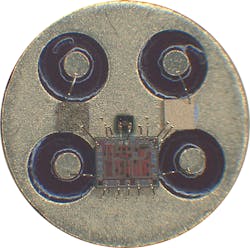Albis Optoelectronics, HiLight Semiconductor collaborate on receiver technology for 10G-PON ONUs
Albis Optoelectronics and HiLight Semiconductor are touting the performance of the former’s APD10F1 avalanche photodiode (APD) and the latter’s SLR10G2 TIA-receiver IC to deliver high performance in 10G PON optical network units (ONUs). The companies demonstrated the combination at this month’s OFC conference and exhibition in San Diego March 7-9.
The companies showed the APD/IC pairing delivering sensitivity levels of -34 dBm (at BER 1E-3) and -28 dBm (at BER 1E-12) packaged in what they describe as “a straightforward TO-can build.” The combination showed less than 1-dB optical sensitivity penalty in the presence of 5~6 GHz WiFi signal sources and almost zero penalty for 2.4 GHz WiFi, the companies add.
The two components enable an efficient TO-can design, Albis and HighLight say. In the demonstration, the bias of the APD10F1 came straight from the SLR10G2 TIA die, thus eliminating the need for biasing circuitry and reducing TO-can BOM costs. The SLR10G2 and APD10F1 can be assembled in a standard side-by-side format within the TO-can package, thus obviating the need for two-stage build processes such as mounting the APD on top of the TIA-LA die.
Device details
The APD10F1 is the newest member of Albis’s 10G APD family. It demonstrates low excess noise and high sensitivity and can be operated at a low bias voltage of typically 30 V to deliver a gain-bandwidth product of 90 GHz, according to the company. The topside-illuminated 10 Gbps photodiode chip features a large dual pad layout to enable the placement of multiple wire bonds on one pad. The pad metallization is optimized for wire-bonding with the pads positioned to enable easy and direct bonding to most common TIA layouts. The APD10F1 chip is fully qualified and available in high volumes.
“Over the past 15 years we have continuously refined our APD product offering and driven performance to the physical limits in order to achieve best-in-class sensitivities and an unsurpassed dynamic range,” states Vincent Grundlehner, CEO of Albis Optoelectronics. “The combination of our low-noise, high-responsivity APD10F1 and HiLight’s SLR10G2 TIA-receiver results in a simplification of the FTTx receiver design while at the same time improving the performance.”
HiLight’s SLR10G2 TIA-receiver IC for APD BOSAs, meanwhile, is the first in what is expected to be a new line of chipsets for PON FTTx. The SLR10G2 is a 10-Gbps combined transimpedance amplifier (TIA) and limiting amplifier (LA) in a single monolithic chip. It features patent-pending active noise suppression circuitry within the TIA-LA front-end that minimizes any sensitivity penalty due to local WiFi antenna or similar RF noise sources often found within consumer ONU boxes, HiLight asserts. In fully limiting mode, the SLR10G2 data outputs maintain a typical 280-mVpp output swing from overload to sensitivity, which can further reduce the effects of external noise sources on optical sensitivity outside of the BOSA package. The SLR10G2 can also operate in a more traditional TIA like mode. The device is sampling now. A 2.5-Gbps GPON optimized version of the SLR10G2 is also available.
“The SLR10G2 chip receiver is the most advanced, highest performance solution for 10G-PON ONUs and will provide exceptional levels of sensitivity performance margin in the noisiest of environments,” asserted Christian Rookes, vice president, marketing at HiLight. “What’s more, the SLR10G2 is designed on the same low-cost CMOS process as the established HLR2S50, HLR10G0, and HLR10G1 TIAs, around 100 million of which have already shipped to customers worldwide.”
For related articles, visit the Optical Technologies Topic Center.
For more information on communications semiconductors and suppliers, visit the Lightwave Buyer’s Guide.
To stay abreast of optical communications technology, subscribe to Lightwave’s Enabling Technologies Newsletter.
About the Author

Stephen Hardy
Editorial Director and Associate Publisher, Lightwave
Stephen Hardy is editorial director and associate publisher of Lightwave and Broadband Technology Report, part of the Lighting & Technology Group at Endeavor Business Media. Stephen is responsible for establishing and executing editorial strategy across the both brands’ websites, email newsletters, events, and other information products. He has covered the fiber-optics space for more than 20 years, and communications and technology for more than 35 years. During his tenure, Lightwave has received awards from Folio: and the American Society of Business Press Editors (ASBPE) for editorial excellence. Prior to joining Lightwave in 1997, Stephen worked for Telecommunications magazine and the Journal of Electronic Defense.
Stephen has moderated panels at numerous events, including the Optica Executive Forum, ECOC, and SCTE Cable-Tec Expo. He also is program director for the Lightwave Innovation Reviews and the Diamond Technology Reviews.
He has written numerous articles in all aspects of optical communications and fiber-optic networks, including fiber to the home (FTTH), PON, optical components, DWDM, fiber cables, packet optical transport, optical transceivers, lasers, fiber optic testing, and more.
You can connect with Stephen on LinkedIn as well as Twitter.
